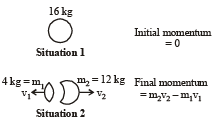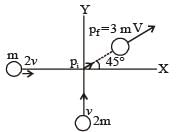Test: 35 Year JEE Previous Year Questions: Momentum and Impulse - JEE MCQ
8 Questions MCQ Test - Test: 35 Year JEE Previous Year Questions: Momentum and Impulse
STATEMENT–1 : In an elastic collision between two bodies, the relative speed of the bodies after collision is equal to the relative speed before the collision.
STATEMENT–2 : In an elastic collision, the linear momentum of the system is conserved.
A machine gun fires a bullet of mass 40 g with a velocity 1200 ms–1. The man holding it can exert a maximum force of 144 N on the gun. How many bullets can he fire per second at the most?
| 1 Crore+ students have signed up on EduRev. Have you? Download the App |
A mass ‘m’ moves with a velocity ‘v’ and collides inelastically with another identical mass . After collision the 1st mass moves with velocity  in a direction perpendicular to the initial direction of motion. Find the speed of the 2nd mass after collision.
in a direction perpendicular to the initial direction of motion. Find the speed of the 2nd mass after collision.

 in a direction perpendicular to the initial direction of motion. Find the speed of the 2nd mass after collision.
in a direction perpendicular to the initial direction of motion. Find the speed of the 2nd mass after collision.
A bomb of mass 16kg at rest explodes into two pieces of masses 4 kg and 12 kg. The velolcity of the 12 kg mass is 4 ms–1. The kinetic energy of the other mass is
Statement -1: Two particles moving in the same direction do not lose all their energy in a completely inelastic collision.
Statement -2 : Principle of conservation of momentum holds true for all kinds of collisions.
The figure shows the position–time (x – t) graph of onedimensional motion of a body of mass 0.4 kg. The magnitude of each impulse is

This question has statement I and statement II. Of the four choices given after the statements, choose the one that best describes the two statements.
Statement - I: Apoint particle of mass m moving with speed  with stationary point particle of mass M. If the maximum energy loss possible is given as
with stationary point particle of mass M. If the maximum energy loss possible is given as  then
then 
Statement - II: Maximum energy loss occurs when the particles get stuck together as a result of the collision.
A particle of mass m moving in the x direction with speed 2v is hit by another particle of mass 2m moving in the y direction with speed v. If the collision is perfectly inelastic, the percentage loss in the energy during the collision is close to :


































